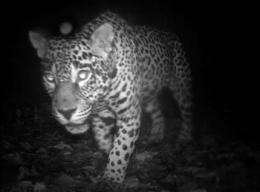Hey tapir, jaguar, smile! You're on Candid Camera

(AP) -- They are the hidden family portraits of Earth's most remote jungles finally revealed: A touching snapshot of an endangered female mountain gorilla carrying an infant on her back. A giant anteater sticking its enormous snout practically in your face. Soulful eyes of a curious chimpanzee, a speedy jaguar and a rare tapir staring back at you.
Researchers are getting an unusual peek into key tropical spots with 420 hidden automatic cameras snapping candid photos of the truly wild. The first of almost 52,000 pictures were released Monday by Conservation International, a group that promotes wildlife protection, and they are wowing some experienced wildlife biologists.
The cameras snapped away during a month of the dry season, starting in 2008, in seven different countries and will continue to take candids in future years.
"These kind of captured them doing what they're doing, being themselves," said study lead author Jorge Ahumada, technical director of the Tropical Ecology Assessment and Monitoring Network.
What's key is that there were no people involved. The cameras were hidden with camouflage and don't have a visible flash. They are heat-sensitive so when something warm is nearby, the camera snaps a picture. The cameras were positioned to study mammals, but also got large birds, lizards and something else: human poachers, guns in hand.
Ahumada and his team positioned the cameras in seven different wildlife preserves in Suriname, Costa Rica, Indonesia, Tanzania, Brazil, Uganda and Laos. Suriname had the most diversity and Laos the least. Their findings were published in Philosophical Transactions of the Royal Society B.
"What a great study," said Stanford University biologist Terry Root, who wasn't involved. "Mammals are very hard to census because they are afraid of humans and they have better ways of hiding than we have of finding them."
More information: http://www.conservation.org
©2011 The Associated Press. All rights reserved. This material may not be published, broadcast, rewritten or redistributed.
















